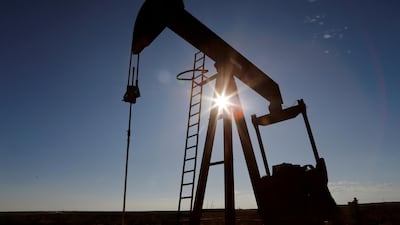Global oil demand is not expected to recover until 2022, the International Energy Agency said in its latest oil market report.
Demand for crude in 2020 is set to drop by 8.1 million barrels per day - the steepest decline in history, the agency said.
However, the recent gains in prices indicate that the worst for the oil markets is over. Demand is expected to recover by 5.7m bpd in 2021.
"While the oil market remains fragile, the recent modest recovery in prices suggests that the first half of 2020 is ending on a more optimistic note," the IEA, which has its headquarters in Paris, said.
"New data show that demand destruction in the early part of the year was slightly less than expected, although still unprecedented."
Oil prices rose to the highest levels in three months in early June, supported by the supply cuts undertaken by the Opec+ alliance.
Brent reached $42.30 per barrel in early June, while West Texas Intermediate, which plunged into negative territory in April, rose as high as $39.60 per barrel.
Brent was up 1 per cent at $40.79 per barrel, while WTI was up 1 per cent at $38.12 per barrel at 4.20pm UAE time.
The IEA expects global supply to also drop 7.2m bpd in 2020, registering only a modest increase of 1.8m bpd in 2021. The agency based this assessment on Opec+ achieving 100 per cent compliance for its production restrictions. The group led by Saudi Arabia and Russia is cutting back 9.7m bpd until July, with tapered cuts to remain in place until April 2022.
US production meanwhile is not likely to recover significantly, in spite of WTI hovering about $40 per barrel this month.
The IEA estimates US production to have fallen to 10.5m bpd in June, a 2.4m bpd decline from its record high in November.
High crude and product stocks will also constrain producers from selling more to refiners, the report said.
The biggest hit to global oil demand comes from the slowdown in air traffic, said the IEA.
"The industry will continue to be a drag on oil demand through 2021, with our first estimate showing that, having fallen by 3m bpd in 2020, jet/kerosene demand will rebound by only 1m bpd in 2021, leaving it below the pre-crisis level," the report said.
Global air traffic will be nearly 55 per cent lower this year compared with 2019, according to the International Air Transport Association.
Meanwhile, global oil supply declined by 11.8m bpd in May, which the agency attributed to record cuts implemented by Opec+ as well as production shut-ins in North America and elsewhere. Supply is expected to pick-up by a modest 1.7m bpd in 2021. The IEA based this assumption on the gradual easing of Opec+ cuts as well as increases in output from Norway, Brazil, Guyana and the possibility of Libyan barrels coming back into the market.
Supply from the US is meanwhile set to decline by 900,000 bpd this year and a further 300,000 bpd in 2021, unless prices surge higher and fresh investments flow into the shale patch.
The agency remains optimistic over the recovery of demand for the second half of the year as lockdown measures ease.
"We have also seen a strong rebound in India in May, although demand is still well below year-ago levels," the report said.


